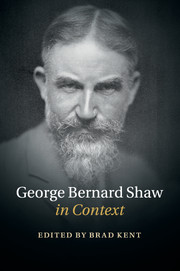Book contents
- Frontmatter
- Dedication
- Contents
- List of illustrations
- Notes on contributors
- Preface
- Acknowledgements
- A Chronology of Shaw's Works
- List of abbreviations
- PART I PEOPLE AND PLACES
- PART II THEATRE
- PART III WRITING AND THE ARTS
- 15 Cinema
- 16 Journalism
- 17 Letters
- 18 Media and technology
- 19 Modernism
- 20 Music
- 21 Novels
- 22 Publishers and publishing
- 23 Visual arts
- PART IV POLITICS
- PART V CULTURE AND SOCIETY
- PART VI RECEPTION AND AFTERLIFE
- Further reading
- Index
- References
19 - Modernism
from PART III - WRITING AND THE ARTS
Published online by Cambridge University Press: 05 October 2015
- Frontmatter
- Dedication
- Contents
- List of illustrations
- Notes on contributors
- Preface
- Acknowledgements
- A Chronology of Shaw's Works
- List of abbreviations
- PART I PEOPLE AND PLACES
- PART II THEATRE
- PART III WRITING AND THE ARTS
- 15 Cinema
- 16 Journalism
- 17 Letters
- 18 Media and technology
- 19 Modernism
- 20 Music
- 21 Novels
- 22 Publishers and publishing
- 23 Visual arts
- PART IV POLITICS
- PART V CULTURE AND SOCIETY
- PART VI RECEPTION AND AFTERLIFE
- Further reading
- Index
- References
Summary
Depending on what standards are chosen, Shaw is either the quintessential modernist or a relic of Victorianism who outlived his time by more than half a century. By contrast with, say, Wyndham Lewis, the proclaimer of Vorticism who published Ezra Pound's early poems along with Futurist manifestos by Filippo Marinetti in his strategically and symbolically titled journal Blast, Shaw's predominantly naturalistic style must have looked artistically conservative. As Lawrence Switzky has pointed out, T. S. Eliot explicitly denied that Shaw belonged in the category of experimental formalism, Einsteinian relativity, subjective vision, or philosophical challenge that characterises Modernism – citing an article on Saint Joan published in The Criterion – by labelling Shaw's protagonist as ‘a disciple of Nietzsche, Butler and every chaotic and immature intellectual enthusiasm of the later nineteenth century’. And indeed the complicated trail of citations (Switzky through Holroyd to Eliot) demonstrates the critical breadth in the rejection of Shaw as a member of the modernist movement. On the other side stand an almost equal number of scholars – for example John Gassner, who claimed Shaw as the ‘maker of the modern mind’, while Raymond Williams declared that ‘Shaw self-evidently was a Modern: indeed “modern” as a description, stuck quite generally … in that self-conscious and very local transition from a Victorian to post-1918 world’. In addition, some have tried to bridge the gap, as Stanley Kauffmann does in his proposal that Shaw's work is characterised by moving ‘Back to the Future’.
However, it is clear that those who support Shaw as a modernist do so on a primarily intellectual basis, as representing a mode of thought specific to the period of social transition leading up to the European cataclysm of World War I, while those who deny him the modernist label do so on the basis of style. There are also those who identify certain plays – Heartbreak House or Back to Methuselah – as modernist. Or the fact that, compared to continental Europe, British theatre remained predominantly naturalistic, while avant-garde experiments had so little influence on its overall development, can be seen as largely due to the presence of Shaw on the British scene.
- Type
- Chapter
- Information
- George Bernard Shaw in Context , pp. 151 - 159Publisher: Cambridge University PressPrint publication year: 2015
References
- 1
- Cited by

